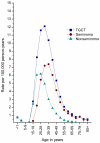Etiologic factors in testicular germ-cell tumors
- PMID: 19903067
- PMCID: PMC3000220
- DOI: 10.2217/fon.09.116
Etiologic factors in testicular germ-cell tumors
Abstract
Globally, testicular cancer incidence is highest among men of northern European ancestry and lowest among men of Asian and African descent. Incidence rates have been increasing around the world for at least 50 years, but mortality rates, at least in developed countries, have been declining. While reasons for the decreases in mortality are related to improvements in therapeutic regimens introduced in the late 1970s, reasons for the increase in incidence are less well understood. However, an accumulating body of evidence suggests that testicular cancer arises in fetal life. Perinatal factors, including exposure to endocrine-disrupting chemicals, have been suggested to be related to risk.
Figures


References
-
- Skakkebaek NE. Possible carcinoma-in-situ of the testis. Lancet. 1972;2:516–7. - PubMed
-
- Oosterhuis JW, Looijenga LH. Testicular germ-cell tumours in a broader perspective. Nat Rev Cancer. 2005;5:210–22. - PubMed
-
- Rajpert-De Meyts E, Jorgensen N, Brondum-Nielsen K, Muller J, Skakkebaek NE. Developmental arrest of germ cells in the pathogenesis of germ cell neoplasia. APMIS. 1998;106:198–204. discussion 204-6. - PubMed
-
- Honecker F, Stoop H, de Krijger RR, Chris Lau YF, Bokemeyer C, Looijenga LH. Pathobiological implications of the expression of markers of testicular carcinoma in situ by fetal germ cells. J Pathol. 2004;203:849–57. - PubMed
Publication types
MeSH terms
Grants and funding
LinkOut - more resources
Full Text Sources
Medical
